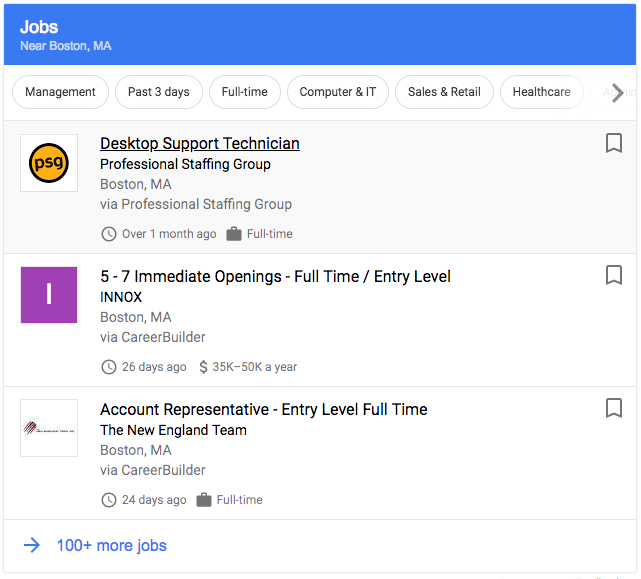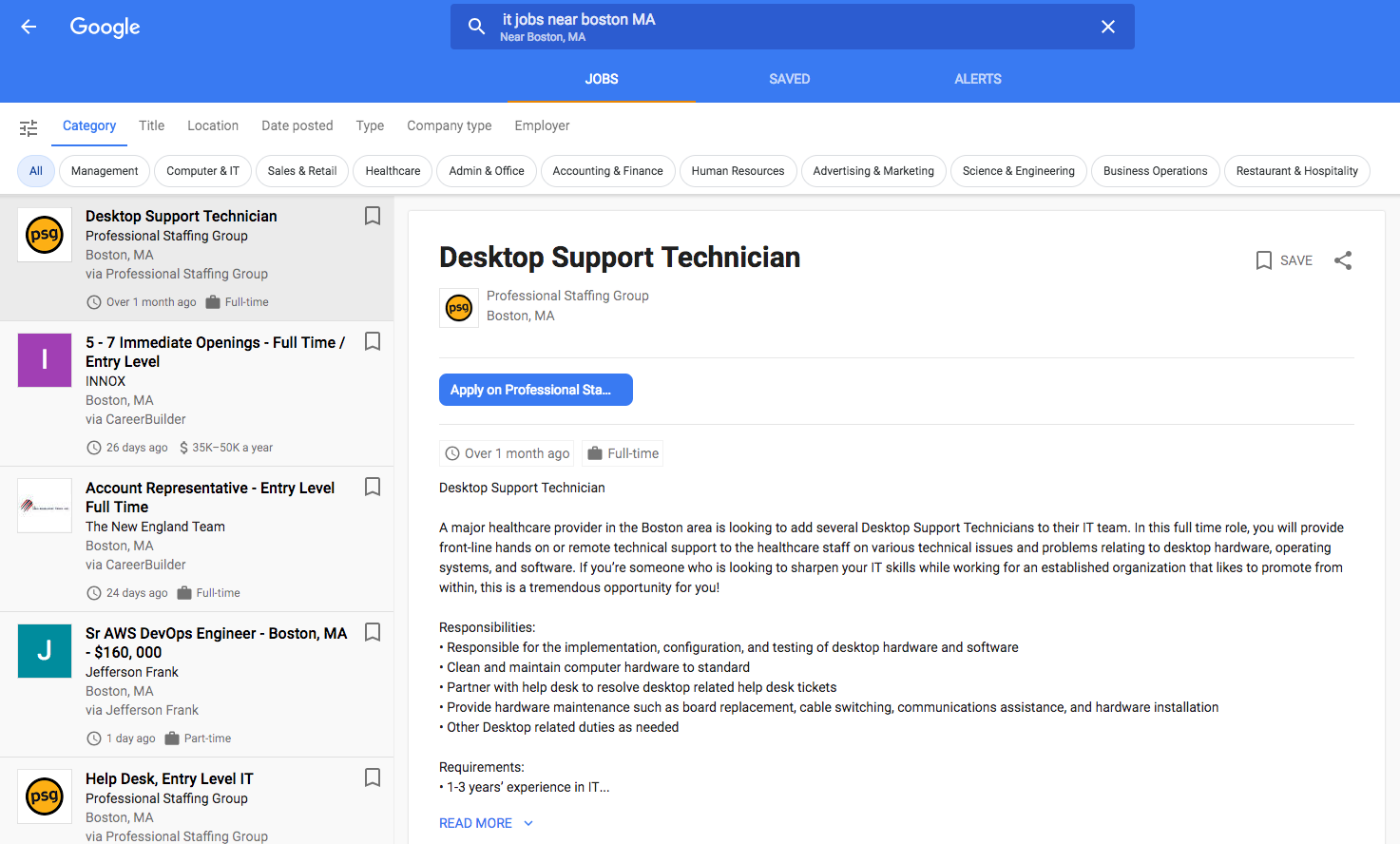Increase Organic Search Traffic to Your Jobs Website with Google for Jobs Optimization

Have you heard about Google for Jobs? If you haven’t, allow me to acquaint you with this incredible tool and convince you that your website needs to be ready for it. Google for Jobs puts your jobs in front of the people looking for them–and at a minimal cost! As a lead developer for Matador Jobs, I helped build Google for Jobs optimization into our software 9 months ago and we’ve now helped over 300 Bullhorn users get on Google for Jobs. We’ve seen some incredible results and learned a few things in the process.
What is Google For Jobs?
Google for Jobs is a new job search platform that is similar to existing job search tools, but introduces some new features that make it stand out:
- You don’t have to ask Google to list your jobs or register as a staffing agency to be on Google for Jobs. Google for Jobs automatically collects job opportunity information everywhere on the internet, provided the website is optimized.
- Unlike other job search platforms, Google for Jobs does not collect applications. Users interested in applying will click a link in the search result that takes them to the job’s website to apply.
- As of now, search results are wholly based on search relevance and not influenced by ads or paid boosting. Google being Google, I expect this to change one day, but for now it offers a unique opportunity to let the relevance to the job seeker drive what they see–not how much was paid for an ad.
- Google for Jobs is shown in the results of any Google web search with a job-seeking context. Job seekers are likely to use the same Google Search bar on their phones, web browsers, and apps, and are therefore are unlikely to ever scroll far enough to explore additional job search websites.
Google for Jobs is live in the Americas, Sub-Saharan Africa, the UK, Spain, Singapore, and India, with new regions coming online soon. If you’re in one of the regions with Google for Jobs and you’re not optimized, you’re already missing out! And if you’re in one of the regions still waiting for the platform, now is the time to get optimized.
> Read More “Google’s newest push to radically improve the online job hunt for millions of Americans”
How Does it Work?
I thought you’d never ask! The best way to explain Google for Jobs is to show you:

Let’s start with something simple. I’m on Google’s Search home page and I’m looking for “IT jobs in Boston.” I press enter and begin the search.

Directly after the paid ads, above the first organic search result, is this colorful box of job listings. I can click on either one of the jobs or the “100+ more jobs” link to see more.

After clicking on the “More Jobs” link, I’m met with a user-friendly, clean listing of jobs from various sources that match my result. You’ll notice the top result is automatically expanded with a full description. If I click on the “Apply” link, it will take me to the job’s website to apply. I can also narrow my results with refined searches and bookmark jobs, among other features.
Overall, it’s simple, straightforward, and, since it’s above standard search results, some users will never end up at another job search website. If you were to list your jobs exclusively on those other job search websites, you’d run the risk of job seekers never viewing your jobs.
Okay, I’m Convinced! Now What?
To get your jobs on Google for Jobs search you need to have a website with a job board optimized for Google for Jobs. Here is what that means:
-
- First, you need a website with a job board. Most staffing and recruiting companies already have a website, but at Matador Jobs, we’ve found that many agencies do not list jobs on their sites. This is a must for Google for Jobs. Matador Jobs uses the Bullhorn REST API to make a job board automatically using job data managed in your Bullhorn ATS. Other software can perform similar functions, but note that, at this time, the Open Source Career Portal is not able to support Google for Jobs optimization.
-
- Each job page needs to have Structured Data about the job. Structured Data is like CliffsNotes about your job listing for the Google robot when it visits your site. Structured Data provides the Google robot with the information for your Google for Jobs listing. To do this, you will need to create a special block of code in JSON+LD format that might look like this:

I’ll repeat: to be listed in Google for Jobs, Structured Data is required. You can find out how to prepare Structured Data using the guides available at the Google for Jobs Developer’s page
- Each job page needs to have Structured Data about the job. Structured Data is like CliffsNotes about your job listing for the Google robot when it visits your site. Structured Data provides the Google robot with the information for your Google for Jobs listing. To do this, you will need to create a special block of code in JSON+LD format that might look like this:
- Job opportunities are added and removed regularly, and for this reason, Google asks you to notify them whenever a job is added or removed to ensure the Google for Jobs listings are as up-to-date as possible. Unlike regular page updates, which will wait until the Google robot’s next scheduled visit to be indexed, when a job is added, changed, or removed, your site should notify Google of the change so the robot can be sent right away. There are two ways to notify Google, both of which are explained in the Google for Jobs Developer’s page
Some Things to Consider
Now that you are up and running with a Google for Jobs optimized website, there are a few things you may want to consider to get the best results. Here are some tips:
- Google for Jobs will hide similar results from your site, so job titles should be unique. For example, if you hire senior staff accountants and have four positions and four different companies open, you should name each position differently. If you have four “Senior Staff Accountant” positions, they’ll be combined by Google for Jobs into one listing. But if you have one “Non-Profit Sector Senior Staff Accountant,” one “Banking Sector Senior Staff Accountant,” etc, each will have its own listing in Google for Jobs.
- The Google for Jobs search prominently factors in location when ranking opportunities. If a seeker searches “jobs near me” or “jobs in Boston,” a job with a full address in its structured data will rank higher than jobs with just a city and state or province. Try to include the full address for each job when possible. The Google for Jobs Developer’s page gives you tips on how to list work-from-home jobs, too.
- Structured Data requires you to define a “Hiring Company.” This can be a staffing and recruiting agency or the actual employer. We more commonly see our users define themselves as the “hiring company.” Google for Jobs allows job seekers to search by a desired company, so this may hurt your ranking if you’re presenting yourself as the hiring company.
- When implementing Google for Jobs, the structured data requests you to provide the expected salary for the job, but it is not required. Most firms do not like to publish the salary or are not allowed to due to contract obligations or the negotiable nature of salaries. This won’t cause your jobs to be ignored but may cause them to be featured less prominently–especially when a job seeker is searching for a desired salary range.
Is it Worth the Work?
It seems like getting optimized for Google for Jobs is a lot of work. But is it worth it? Yes! Yes it is! One of our clients installed our software with its Google for Jobs support on a Thursday afternoon but didn’t make the new job board visible to public site visitors. The client called me in the morning somewhat panicked but also happy: “We got 35 applications overnight!” They hadn’t even gone live yet, but a Google robot found their hidden new job board and directed 35 applicants to them in just 12 hours! Remember: these were applications they didn’t drive traffic to with ads or promotions, but were generated by purely organic search results thanks to Google for Jobs. This is just one example, and we have many, including a customer who saw a 75% increase in organic search traffic to her site in just one month. Once optimized for Google for Jobs, you, too, will see results like this!
Now, Go Get Optimized!
I hope this introduction to Google for Jobs and the high-level overview of how to optimize your company’s website for it helps you see the tremendous opportunity Google for Jobs has for your business. If you have a development team at your firm who can update your site for Google for Jobs, get them going on it! If you need a little help, feel free to reach out to Bullhorn Marketplace Partners who can help you leverage the Bullhorn REST API and Google for Jobs on your site, including Matador Jobs. We’re ready to help!